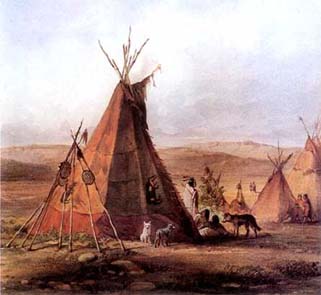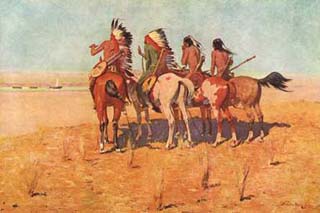Anth 3511 Professor Gibbon
1. Introduction.
Bison Hunters on the Plains
A. The Plains is associated with two ingrained myths:
(1) The Plains were an uninhabitable desert (the Great American Desert)
(2) All Plains Indians (and in fact all Indians) were fierce warriors who wore bonnets, etc.; this stereotype has been popularized through Wild West shows, novels, western movies, paintings, etc.
B. In reality the Plains one of the longest occupied archaeological areas of North America; two life-way trajectories were present on the Plains, a focal bison hunter life-way and a village farmer life-way. We focus here on the first.
2. The Plains environment and its changes through time
A. The Great Plains is a large area (ca. 8 million square miles) that stretches from the Rockies into Illinois and from Canada to the Rio Grande.
B. Some general characteristics of the plains are: low to moderate relief relatively low rainfall that usually occurs as highly localized thunderstorms; hot summers and very cold, long winters; short-grass plains west of the 100th meridian and tall-grass prairie east of the 98th meridian, with bison preferring the more nutritious short grassi
C. Because of the diversity of the Plains, it has been divided into 5 regions: Northwestern Plains, Middle Missouri Valley, Northeastern Plains, Central Plains, and Southern Plains.
D. The climate of the Plains is dominated by 3 major air masses (mild Pacific; moist, warm tropical; cold, dry arctic) whose clash is responsible for the turbulent weather of the area.
E. During the moister Early Holocene (c. 10,500-6500 BC), the trend was toward increasing dryness and the spread of grasslands. The peak of the dry trend occurred in the Middle Holocene (c. 6500-2000 BC), when grasslands reached their greatest post-Ice Age extent. The Late Holocene (c. 2000 BC to present) coincides with essentially modern environmental conditions.
F. A series of bison species (Bison antiquus, Bison occidentalis, Bison bison) successfully adapted to the shifting and regionally variable environmental conditions of the Plains.
3. The Plains Archaic Tradition (c. 5600 BC - AD 500)
A. Some characteristics and trends of the poorly known Plains Archaic:
'Cultures' are primarily defined by the presence of distinctive side - and corner-notched projectile points, such as McKean and Besant. There is a trend toward a more diversified economy, especially during periods when bison are less abundant (e.g., the 'Altithermal'). Besides bison, antelope, deer, bears, small mammals, fish, shellfish, and wild vegetable foods (e.g., prairie turnips) were eaten. These highly mobile
A.(1) hunter-gatherers followed a carefully thought out annual schedule of economic activities.
Toolkits became more diversified (a reflection of the more diversified economic system).
Bison-hunting methods became more effective through time, stressing arroyo-trap systems, then corals, then bison jumps. There was probably a gradual increase in population through time, although social units remained small family bands that aggregated together for social and economic functions.
As during the Paleo-Indian period, communal bison hunts were probably carefully controlled, ritual activities with shamans present.
Middle Plains Archaic terms to remember include McKean complex, stone circles, artificial corrals;
Late Plains Archaic terms include Besant, and the Ruby and Muddy Creek corrals in Wyoming.
Later Bison Hunters (c. AD 550-1880)
A. Trends among bison hunters on the Plains after c. AD 550 include:
An increasing intensity of bison hunting, first with the appearance of the bow and arrow (c. AD 100-500), then the horse, and finally guns and trappers.
Bison jumps became of increasing importance.
New exchange patterns developed with neighboring farmers in which meat and robes were exchanged for domesticated plant foods and other items.
B. The focal bison hunting way of life disappeared by 1880 with the extermination of the bison herds.
C. Written descriptions of life-ways on the Plains begin in the mid-16'h century with Spanish (e.g., Coronado) excursions onto the Southern and Central Plains. They describe, for example, the use of dogs as pack animals. There was no domesticated pack animal except for the dog before the historic introduction of the horse.
D. Already by c. AD 1500 various Indian groups were moving onto the Plains, although we are not sure why. Large numbers of groups moved onto the Plains for a variety of reasons during the early historic period (c. 17th-19th centuries).
Go To The Index Page


